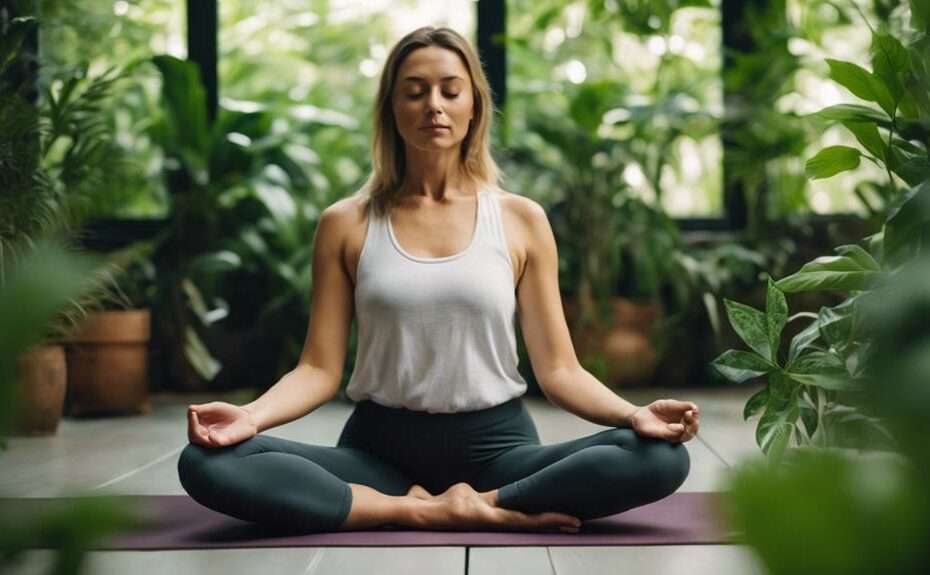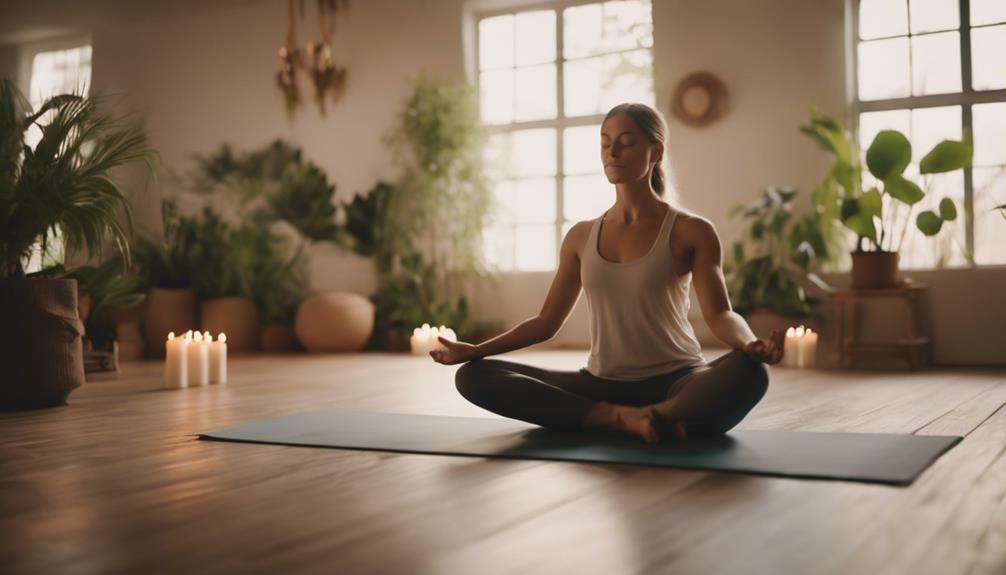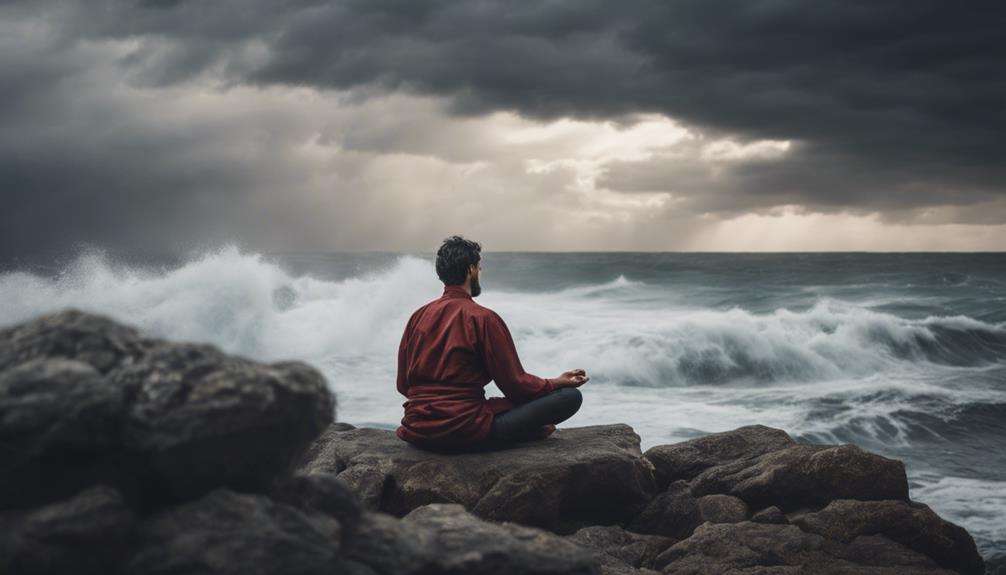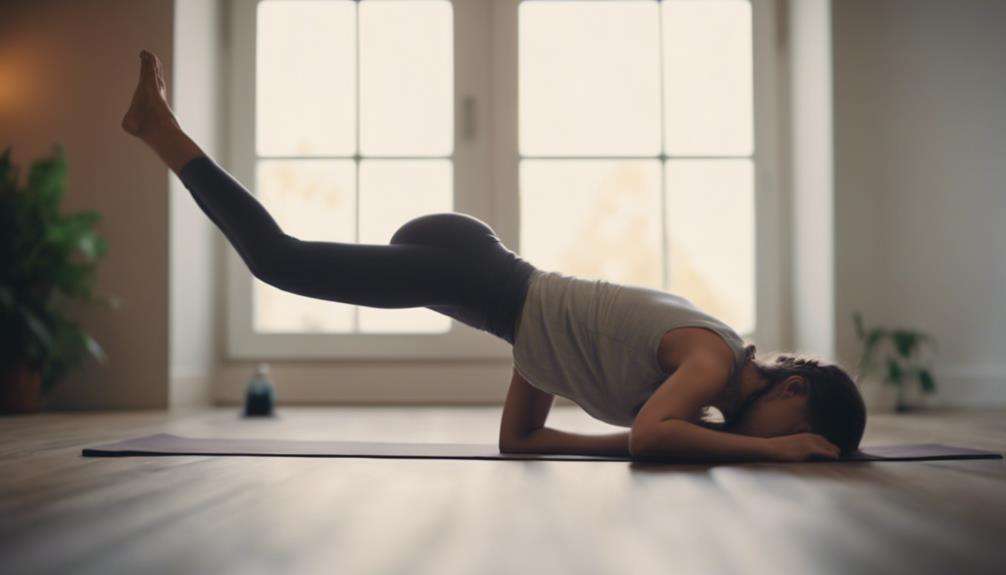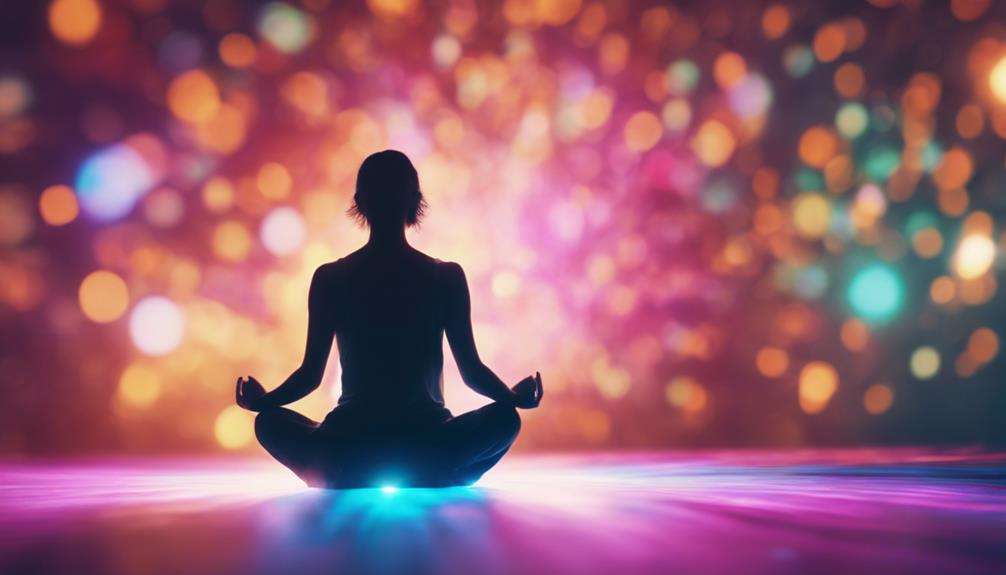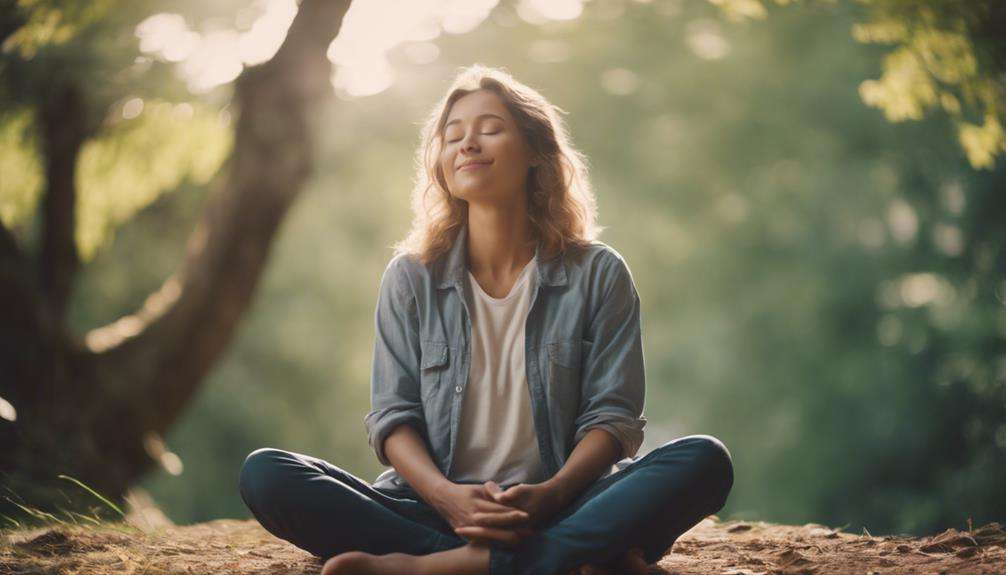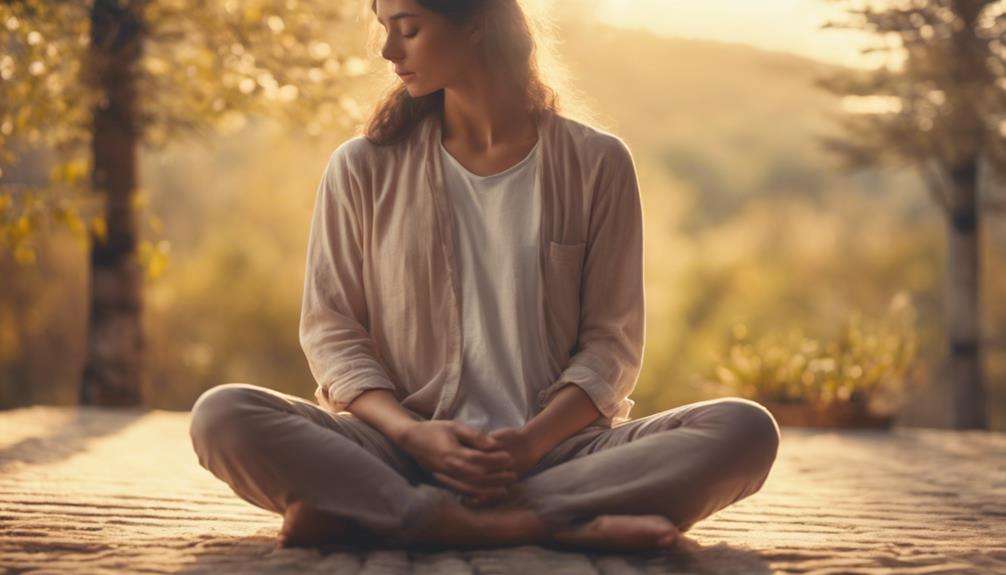Imagine anxiety as a turbulent ocean, with its waves crashing unpredictably.
Now, consider yoga and meditation as your anchor, providing stability and calm in the midst of life's storms.
The practice of yoga and meditation offers a profound sense of relief from anxiety, but how exactly do these ancient techniques work their magic on your mind and body?
By exploring the intricate relationship between breath, movement, and mindfulness, you'll uncover a world of benefits that go beyond mere relaxation.
Key Takeaways
- Yoga and meditation lower stress hormones and increase beneficial brain chemicals.
- They enhance cognitive function, emotional regulation, and self-awareness.
- Mind-body practices like breath awareness and poses support anxiety relief.
- Meditation techniques like mindfulness and deep breathing promote inner peace and stress management.
Yoga and Meditation Techniques for Anxiety Relief
Yoga and meditation techniques offer practical and evidence-based approaches for alleviating anxiety symptoms through regulating the nervous system and enhancing self-awareness. Deep, steady breathing patterns in yoga play a crucial role in calming the sympathetic nervous system, which can help individuals experiencing anxiety to achieve a state of relaxation.
By focusing on controlled breathing exercises during yoga sessions, you can effectively reduce feelings of tension and promote a sense of calmness within yourself. Additionally, mindfulness meditation techniques incorporated into yoga practices can significantly enhance your self-awareness and mental clarity, providing you with valuable tools to manage anxious thoughts.
Specific yoga poses such as Child's Pose and Corpse Pose are designed to release physical tension and promote relaxation, contributing to an overall sense of well-being. Engaging in body scan meditation practices during yoga sessions can further aid in staying present in the moment, assisting you in reducing anxiety and fostering a peaceful state of mind.
Physical Benefits of Yoga for Stress Reduction
Regular practice of yoga offers a multitude of physical benefits that contribute to reducing stress and promoting overall well-being. Yoga plays a crucial role in stress reduction by lowering stress hormones like cortisol and increasing levels of gamma-aminobutyric acid (GABA), which aids in anxiety relief.
This practice not only slows brain aging but also enhances brain function, protecting memory and reducing stress levels. Brain imaging studies have shown that yoga practitioners exhibit higher levels of beneficial brain chemicals, further supporting its stress-reducing effects.
Mental Benefits of Meditation for Anxiety
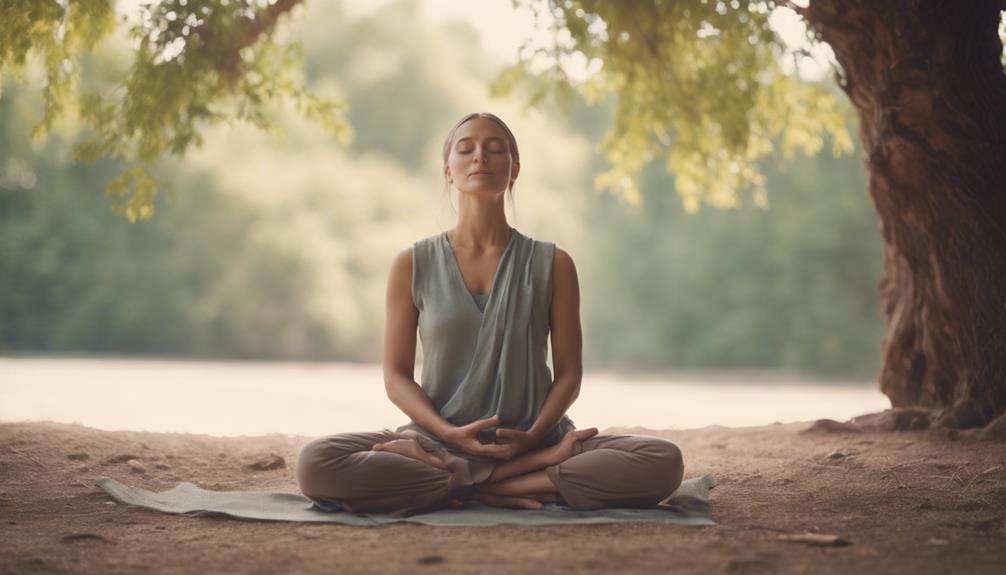
Meditation practice for anxiety management has been shown to significantly enhance cognitive function and memory recall. Regular meditation not only aids in reducing anxiety symptoms but also improves emotional regulation. Mindfulness meditation specifically benefits individuals with anxiety by promoting self-awareness and decreasing rumination.
Moreover, engaging in meditation increases gray matter in brain regions associated with emotional control and stress regulation. This growth in gray matter can lead to better stress regulation and overall mental well-being. By incorporating mindfulness practices like meditation into your routine, you can effectively reduce the impact of negative emotions on your mental health.
Embracing these mental benefits of meditation for anxiety relief can empower you to cultivate a more balanced and resilient mind. Through consistent practice, you can enhance your cognitive abilities, regulate your emotions, and foster a deeper sense of self-awareness, ultimately contributing to a healthier mindset.
Mind-Body Connection in Yoga Practice
As you explore the mind-body connection in yoga practice, key aspects to consider include:
- Breath awareness techniques
- Physical poses alignment
- Focusing on sensations
These elements play a crucial role in fostering a deeper understanding of how your mind and body interact during your yoga sessions. By honing in on these points, you can enhance your practice and tap into the holistic benefits that yoga offers for anxiety relief.
Breath Awareness Techniques
Incorporating breath awareness techniques in yoga practice enhances the mind-body connection by focusing on conscious breathing patterns.
- Regulating Breath: These techniques help regulate breath to calm the sympathetic nervous system and reduce anxiety.
- Promoting Relaxation: Mindful breathing in yoga practice promotes relaxation, reduces stress levels, and enhances mental clarity.
- Synchronizing Breath with Movement: By synchronizing breath with movement, individuals can achieve a state of calmness and improve overall well-being.
- Stimulating Vagus Nerve: Practicing breath awareness techniques in yoga can stimulate the vagus nerve, crucial for modulating the stress response and promoting relaxation.
Physical Poses Alignment
Enhancing your yoga practice through proper alignment in physical poses fosters a profound mind-body connection, optimizing energy flow and promoting balance. When you align your body correctly in yoga poses, you heighten body awareness and concentrate more effectively during your practice.
Mindful alignment ensures that you execute poses safely and efficiently, reducing the risk of injuries while maximizing the benefits of each pose. By focusing on alignment, you gain a deeper understanding of how each posture impacts both your physical and mental well-being.
Proper alignment supports the smooth flow of prana, the life force within you, enhancing the holistic benefits of your yoga practice. Embracing alignment in your poses can lead to a more enriching and fulfilling yoga experience.
Focus on Sensations
Focusing on sensations in yoga practice facilitates a stronger mind-body connection, enhancing the overall experience and promoting mindfulness. When you tune into the sensations in your body during yoga, you can benefit from:
- Valuable Feedback: Sensations provide insight into your body's limits and capabilities, guiding you to practice safely and effectively.
- Enhanced Awareness: Being present with sensations allows you to observe and understand your body's responses to different poses, promoting a deeper connection.
- Improved Alignment: Mindful attention to sensations helps you adjust and align your body correctly, reducing the risk of injury and enhancing the benefits of each pose.
- Promoted Relaxation: Sensory awareness in yoga enables you to relax more deeply and release tension, promoting a sense of calm and well-being.
Breathing Exercises for Anxiety Relief
Utilizing diaphragmatic breathing techniques in yoga can effectively reduce anxiety by activating the parasympathetic nervous system. Controlled breathing exercises, such as alternate nostril breathing, play a vital role in calming the mind and alleviating stress levels.
Deep breathing practices incorporated in yoga help in lowering cortisol levels, the stress hormone, which in turn promotes relaxation and aids in anxiety relief. Techniques like breath-focused meditation, including box breathing, are beneficial for regulating emotions and mitigating symptoms of anxiety.
Consistent engagement in pranayama exercises not only enhances oxygen flow but also boosts mental clarity, supporting overall well-being in managing anxiety. By incorporating these various breathing exercises into your routine, you can experience a profound impact on reducing anxiety levels and promoting a sense of calmness and relaxation in your daily life.
Yoga Poses for Relaxation and Calmness
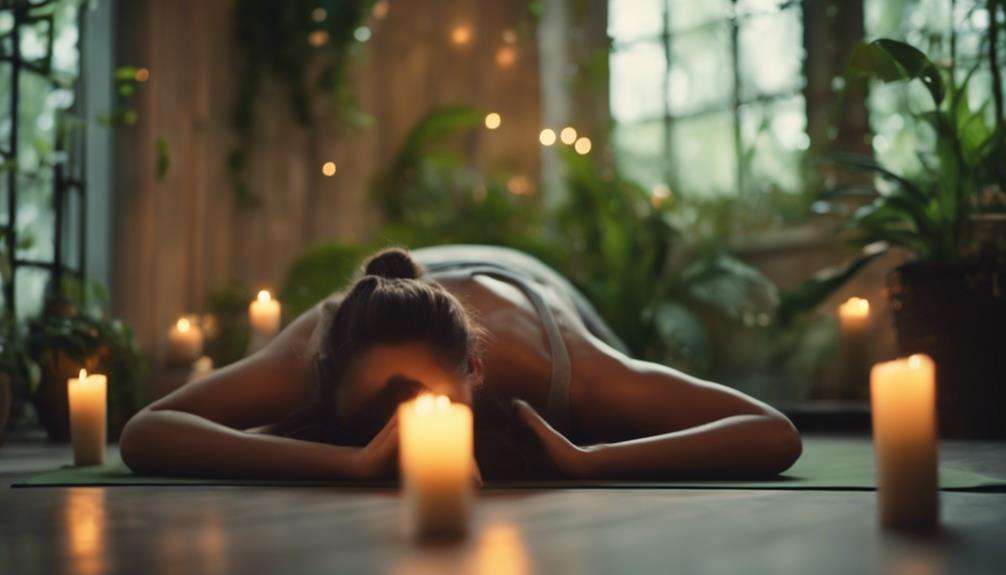
To further enhance your journey towards anxiety relief through yoga, let's explore the calming and relaxation-inducing yoga poses that can support your mental well-being.
- Child's Pose: This pose promotes grounding and relaxation by calming the mind and relieving stress in the body. By assuming a fetal position on the floor, you can find a sense of security and peace.
- Legs Up the Wall Pose: By elevating your legs against a wall, this pose helps reduce anxiety and promote relaxation by improving blood circulation and calming the nervous system. It allows you to let go of tension and invite a sense of calm.
- Corpse Pose: The Corpse Pose induces deep relaxation and calmness by allowing the body to rest fully and release tension. This pose is excellent for unwinding and rejuvenating both the body and mind.
- Cat-Cow Stretch and Warrior Poses: The Cat-Cow Stretch increases spinal flexibility and reduces anxiety, while Warrior Poses empower and strengthen both the body and mind, instilling a sense of confidence and stability to alleviate anxiety. These poses encourage gentle movement and strengthen your mental resolve.
Meditation Practices for Inner Peace
Engage in meditation practices that promote inner peace and emotional well-being, such as mindfulness meditation and loving-kindness meditation.
Mindfulness meditation involves focusing on the present moment without judgment, reducing anxiety and promoting relaxation. Loving-kindness meditation fosters compassion towards oneself and others, enhancing connection and peace.
Techniques like deep breathing exercises and body scan meditation can calm the mind and alleviate anxious thoughts. Regular meditation sessions can rewire the brain's response to stress, increasing resilience and inner peace.
By incorporating these practices into your daily routine, you can cultivate a sense of tranquility and emotional balance. Allow yourself the time and space to explore the benefits of meditation, dedicating moments each day to nurture your mental well-being.
Embracing these meditation practices can help you navigate life's challenges with a clearer and more centered mind, promoting a sense of inner peace and emotional equilibrium.
Holistic Approach to Anxiety Management
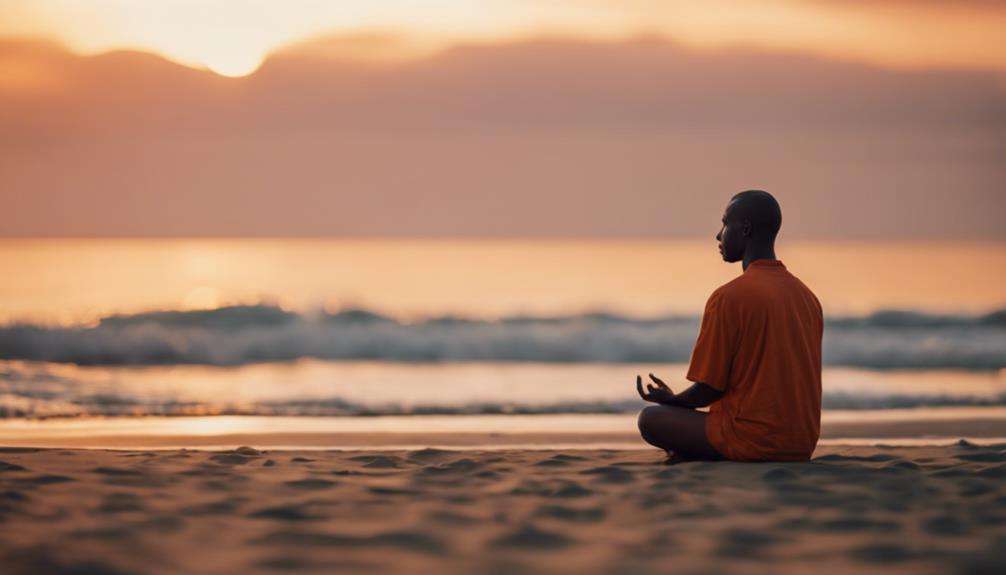
When managing anxiety holistically, it's crucial to consider the mind-body connection and stress reduction techniques.
Yoga and meditation address these aspects by promoting relaxation, reducing stress, and enhancing self-awareness.
Incorporating breath work, movement, and mindfulness into your routine can provide effective tools for managing anxiety symptoms.
Mind-Body Connection
How does the mind-body connection play a crucial role in the holistic management of anxiety through yoga and meditation? The interconnectedness of mental and physical well-being is fundamental in alleviating anxiety. Here's how it works:
- Addressing Root Causes: By recognizing the link between thoughts and physical sensations, yoga and meditation help identify and address the underlying causes of stress and anxiety.
- Balanced State: Integrating mental and physical practices enables individuals to achieve a balanced and harmonious state, which can significantly reduce anxiety symptoms.
- Nurturing Interconnectedness: The holistic approach nurtures the connections between emotions, thoughts, and physical experiences, fostering a deeper understanding of one's internal processes.
- Enhanced Awareness: Emphasizing the mind-body connection cultivates awareness, empowering individuals to better manage and alleviate their anxiety.
Stress Reduction Techniques
Recognizing the integral role of stress reduction techniques in the holistic management of anxiety, yoga and meditation offer effective practices to alleviate symptoms and promote overall well-being. These holistic approaches focus on calming the mind, regulating breathing, and inducing relaxation to combat anxiety.
By incorporating stress reduction techniques from yoga and meditation, individuals can enhance self-awareness, cope with anxious thoughts, and cultivate inner peace. The calming effects of these practices not only reduce anxiety levels but also contribute to an improved sense of well-being.
Through consistent practice, individuals can develop the tools necessary to manage stress, reduce anxiety, and attain a state of inner calmness and equilibrium.
Frequently Asked Questions
How Does Yoga and Meditation Help With Anxiety?
Yoga and meditation assist in anxiety relief by enhancing the mind-body connection, reducing stress through deep breathing, fostering mindfulness practices, regulating emotions, triggering relaxation responses in the nervous system, increasing self-awareness, utilizing grounding techniques, and building coping skills.
Why Is Meditation Helpful for Anxiety?
Using mindfulness practice is akin to taking a deep breath amid chaos. It aids in stress reduction, emotional regulation, and self-awareness. Deep breathing and other relaxation techniques foster inner peace and cognitive restructuring for anxiety relief.
How Long Does It Take for Yoga to Help Anxiety?
You can begin feeling immediate relief from anxiety after just one yoga session. With consistent practice, you may notice short-term improvements within weeks and experience long-term benefits like stress reduction, improved focus, and emotional regulation.
What Are the Mental Benefits of Yoga and Meditation?
Yoga and meditation offer a myriad of mental benefits. They enhance the mind-body connection, provide emotional balance, clarity, and self-awareness, trigger the relaxation response, improve focus, regulate mood, foster inner peace, and build resilience.
Conclusion
In conclusion, yoga and meditation serve as powerful tools for managing anxiety by fostering a harmonious connection between mind and body.
Like a soothing melody that resonates within, these practices offer a sanctuary of calmness and tranquility amidst life's chaotic rhythms.
Embrace the practice of yoga and meditation to unlock the transformative power of inner peace and emotional well-being. Let your journey towards anxiety relief be guided by the gentle flow of breath and mindfulness.
